Introduction
Early childhood caries (ECC) is a unique3.6ttern of dental decay afflicting infants and young children.[6] As we enter the next millennium, dental caries remains a significant problem. The increased prevalence, high cost associated with ECC has lead some researchers to look beyond biological factors and explore behavioral factors to understand ECC's development and prevention.[11]
Infant temperament, in particular has received considerable attention as a tendency to crying and as an early predictor of clinical problems.[4],[2] Temperament refers to an infant's style of interaction with the environment, and appears heritable and stable across time, but modifiable by later environmental influences[3]. Studies have shown that children with "difficult" temperament were more likely than those with "easy" ones to develop behavior disorders.[13],[14]
Both feeding and temperament have seldom been considered together, nor have they been distinguished from other potentially important variables, especially in nonclinical populations.
There are multiple approaches to measuring childhood temperament including temperament scales, maternal reports, naturalistic measures and laboratory observations. The use of temperament questionnaires has gained acceptance by parents who consider that it enhances the understanding and management of their children. When associated with inappropriate feeding habits, ECC results in demineralization of the primary dentition, starting from maxillary anterior teeth and followed by maxillary and mandibular primary molars.[10]
Keeping this in mind, we conducted a study to determine if a relationship exists between a mother's perception of her child's temperament and child's risk factors for ECC.
Materials and Methods
Two hundred children of 2-6 years age reporting to the Department of Pedodontics and Preventive dentistry, National Dental College, Dera Bassi, Mohali were evaluated between March 2011 to October 2011. The eligibility criteria for this study included healthy child status (ASA I) and the presence of all four maxillary primary anteriors and maxillary first primary molars. Informed consent was taken from the parents explaining the aim, importance of the study.
First, a Demographic survey data regarding the child's age, gender, and educational status of the mother, parent's occupation and mother's perception of her child's temperament was collected. The questionnaire consisted of a printed form which included series of questions regarding child's feeding practices, oral hygiene practices, and mother's perception of her child's temperament. It was made in English, Hindi and regional language (Punjabi). It was designed to be as simple as possible and included all the important etiological factors. Questionnaire form was filled by the mothers. Children were then examined in the presence of mother.
All eligible children were clinically examined in a dental chair using light source, mirror to diagnose caries using d1d2-3 caries criteria.[16] (Table 1) No attempt was made to probe or radiograph the teeth. Dental examinations were carried out by one dentist.
Using EAS Temperament scale for children as a standard reference, questionnaire was set.[3] (Table 2)
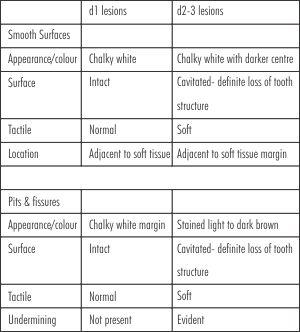 | Table 1 . Caries Diagnosis Criteria
 |
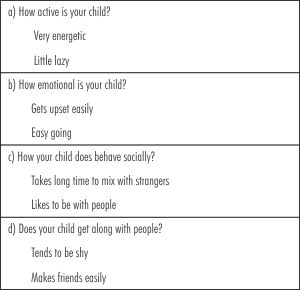 | Table 2. Sample questions using EAS Temperament scale
 |
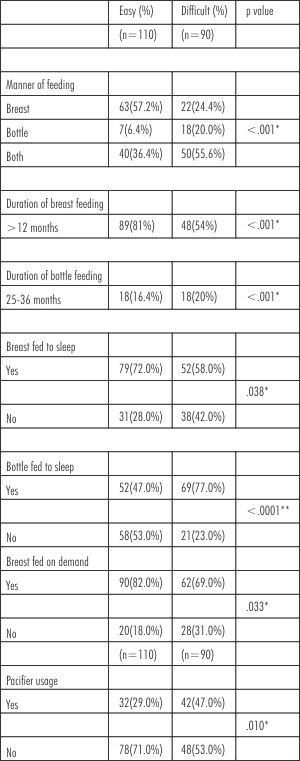 | Table 4. Relationship Between Perceived Temperament And Oral Hygiene Practices(n=200)
 |
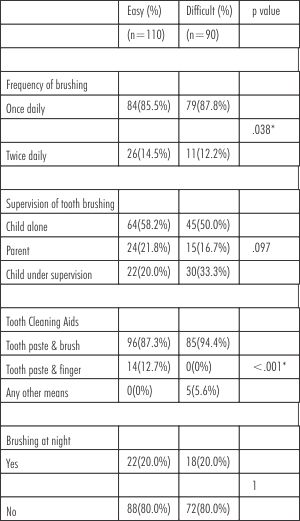 | Table 3. Relationship Between Perceived Temperament And Feeding Habits (n=200)
 |
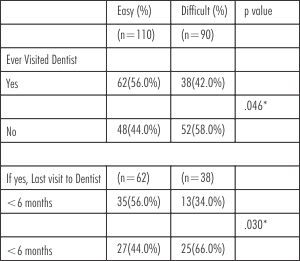 | Table 5. Relationship Between Perceived Temperament And Past Dental Status(n=200)
 |
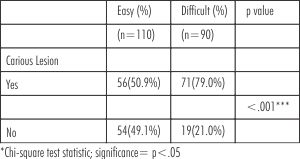 | Table 6. Relationship Between Perceived Temperament And Caries (n=200)
 |
Responses were divided into either "easy" or "difficult" according to mother's perception for the purpose of statistical analysis. The data were subsequently processed and analyzed using the SPSS statistical Software program. Chi - Square test was employed to evaluate the results. All tests had 0.05 level of statistical significance. This study was approved by the Institutional Review Board.
Results
Data was collected from 200 records of children ages from 2 to 6years. Ninety nine subjects were males (41%) and one hundred and one were females (59%). A significant relationship was found between temperament reported by mothers and child's gender where males were more likely to be perceived as "difficult" than females, the difference being statistically significant(p=0.016). 110(55%) of the subjects were reported by their mothers as "easy" and 90(45%) were reported as "difficult". Relationship between perceived temperament of child and the child's feeding habits was found to be varying significantly (Table 3). As for brushing habits, significant relationship was found between "difficult" and "easy" children regarding their oral hygiene practices (Table 4). Perceived temperament and past dental status of child also shown to have statistically significant results (Table 5). Lastly, "difficult" children were found to have carious lesion significantly more often than "easy" children (Table 6).
Discussion
The present study is an effort to link child's temperament using EAS Temperament scale and ECC. The results revealed that children perceived as "easy" were more likely to be breast fed to sleep. The scientific literature available on breast-feeding and its relationship to dental caries is meager as that related to bottle-feeding.[11] Valaitis et al was unable to draw conclusions regarding the relationship between ECC and breast-feeding. This is because of inconsistencies in the methodology and differences in definitions of ECC and breast feeding.[15] Unlike other studies, this research correlates child's temperament with breast-feeding or oral hygiene habits.
Literature has shown that if child maintains low sugar diet and good oral hygiene, caries incidence is less in breast fed children.[1],[12],[17] Current study suggested that children perceived as "difficult" took bottle to bed more often and were at higher risk for caries development. This corroborates the earlier findings.[5],[6]
Besides feeding duration; timing, frequency and content of feeding may also be related to temperament10. In our study, "easy" children were breast fed beyond 12 months and "difficult" children were bottle fed up to 25-36 months. Also stated in literature that children who were breast fed had less caries as compared to those who were bottle fed.[5]
Maziade et al and Prior et al, reporteda greater proportion of boys to have a difficult temperament, harder for their mothers to manage and showed more behavior problems.[7],[9]. Our results are in confirmation to the available data. Males were more likely to be perceived as "difficult" than females. This might be because of our social set up; boys are believed to be of active temperament as compared to girls.
Majority of the children, irrespective of "easy" or "difficult" group used tooth brush and paste as a tooth cleansing aid.This study has showed that "easy" children had their teeth brushed twice daily because they possibly did not protest as much as "difficult" children.Most of the children were found to brush their teeth once daily. Non significant results were found for brushing under supervision and night brushing.
"Easy" children had reported to visit dentist significantly more often than "difficult" children. Moreover, last visit to dentist within 6 months was more often for "easy" children. "Difficult" children were found to have more caries as compared to "easy" children.
Using simple method of child's temperament assessment, our results showed relationships between mother's perceptions of child's temperament and ECC. It is of paramount importance that the caregiver/parent be aware of the potential ramifications of each etiological factor and correct it at the earliest.
By identifying child's temperament, parents can be educated on what attempts can be made to modify child's behavior. Besides these, clinician may suggest alternative methods of parental management when the child, the environment and the parent are not interacting in an effective way. Proper anticipatory guidance, periodic dental checkups and adequate preventive and corrective treatment for the diseased can avoid the severity of dental caries in children in "easy" and "difficult" groups.
Conclusion
Results of the present study concluded that:
Children perceived as "easy" were more likely to be breast fed, have their teeth brushed twice daily.
Children perceived as "difficult" were more likely to be males and were bottle fed, had their teeth brushed once daily and had higher incidence of carious lesions.
Maternal reported child temperament may be related to important early childhood caries risk factors.
References
1. Alaluusua S, Myllarniemi S, Kallio M, Salmenpera L, Tainio VM. Prevalence of caries and salivary levels of mutans streptococci in 5-year-old children in relation to duration of breast feeding. Scand J Dent Res 1990;98:193-196.
2. Bates JE. The concept of difficult temperament. Merrill-Palmer Q. 1982;26:289-319.
3. Buss A, Plomin R: Temperament: Early developing personality traits. Hillsdale NJ: Erlbaum, 1984.
4. Carey WB. Maternal anxiety and infantile colic. Is there a relationship? Clin Pediatr . 1968;7:590-595.
5. Holt RD, Joels D, Bulman J, et al. A third study of caries in preschool aged children in Camden. Br Dent J. 1988;165:87-91.
6. Marino RV, Bomze K, Scholl TO, Anhalt H. Nursing bottle caries: characteristics of children at risk. Clin Pediatr (Phila).1989;28(3):129-31.
7. Maziade M, Cote R, Boudreault M, Thivierge J, Caperaa P. The New York longitudinal studies model of temperament: Gender differences and demographic correlate in a French-speaking population. J Am Acad Child Adolesc Psychiatry 1984;23:582-587.
8. Moy C. The relationship of dental caries and child temperament in preschool children [master's thesis]. Columbus, Ohio: The Ohio State University; 1992.
9. Prior M, Sanson AV, Oberklaid F. The Australian temperament project. In: Temperament in Childhood. Kohnstamm GA, Bates JE, Rothbart MK, eds. New
10. Quinonez R, Santos RG, Wilson S, Cross H. The relationship between child temperament and early childhood caries. Pediatr Dent. 2001 Jan-Feb;23(1):5-1
11. Spitz AS, Weber-Gasparoni K et al. Child temperament and risk factors for early childhood caries. J Dent Child 2006;73:98-104.
12. Tank G, Storvick CA. Caries experience of children one to six years old in two Oregon communities (Corvallis and Albany). III. Relation of diet to variation of dental caries. J Am Dent Assoc 1965;70:394.
13. Thomas, A. and Chess, S. 1977. Temperament and Development. Brunner/Mazel, New York.
14. Thomas, A. Chess, S. and Birch, H. 1968. Temperament and Behavior Dispoders in Children. New York University Press, New York.
15. Valaitis R, Hesh R, Passarelli C, Sheehan D, Sinton J. A systematic review of the relationship between breast-feeding and early childhood caries. Can J Public Health 2000;91:411-417.
16. Warren JJ, Levy SM, Kanellis MJ. Dental caries in the primary dentition: assessing prevalence of cavitated and noncavitated lesions. J Public Health Dent. 2002 Spring;62(2):109-14.
17. Winter GB, Rule DC, Mailer GP, James PMC, Gordon PH. The prevalence of dental caries in preschool children aged 1 to 4 years. Br Dent J 1971;130:271.
York, NY: John Wiley; 1989:537-556. |